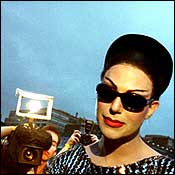
By tradition, a stage is never left completely dark when the show is over: A bare bulb known as the ghostlight burns all night. Martha Graham called it “a symbol of all the lives and legends that are still in this theater.” Too bad the great pioneer of modern dance couldn’t know that after her death she would be awarded her own personal ghostlight, in human form. There’s no other category in which to put Richard Move’s relation to Graham, no performance mode that adequately describes what he does in her name. Such terms as drag and parody seem irrelevant. He is Graham’s ghostlight: When he shines, the glitter we see is hers.
Since 1996, Move has been staging Graham evenings in New York and around the country, declaiming her fulsome truths about life and art and offering loopy versions of her most famous works, accompanied by dancers he plucks right from the Graham school and company. Now this funny, loving, dazzling homage has been captured in Ghostlight, a film by Christopher Herrmann that is currently playing at the Pioneer Theater.
Herrmann, who worked with Graham from 1987 until her death in 1991, loosely structures the film as a fictional documentary. Downtown performer Ann Magnuson plays Barbara Rosen, a filmmaker long besotted with Graham who’s following her idol with a camera crew as she choreographs a new work. There’s a story line of sorts involving a financial crisis; there are cameo appearances by Mark Morris, Deborah Harry, and Isaac Mizrahi; but the main event is Move. Rosen watches starry-eyed as Graham—six-four, draped in robes and adorned with jewels, her eyes made up so richly they could be a couple of peacocks—grandly descends a winding stair in a sumptuous duplex. She doesn’t greet her guests so much as acknowledge a fresh audience. “The necklace is a gift from the Emperor Akihito,” she announces in a breathy, operatic alto, gazing up toward the balcony of a theater only she can see. It’s her version of “Nice to meet you.”
Move’s Graham is a fully realized entity; there isn’t a hint of hairy-legged humor in this characterization. Plunging across the rehearsal studio as a crazed and ravaged Phaedra, berating her assistants, flinging wisdom at her company (“You must dance from your vagina!”), or contemplating the city from her rooftop with a bottle of whiskey, Graham towers like one of those giant Buddhas that dwarfs all worshippers. Herrmann includes wonderful sequences of fake historical footage showing the youthful Graham working ardently with her disciples, or racing through a dreamscape in a toga, hair flying in the wind—imagery that seems to be emanating from Graham’s own psyche. Move’s version of Graham operates as if he’d been able to locate the exact person Graham dreamed of being, the one she carefully placed in the mirror to play the part of her reflection. Is it possible that the impersonation of a genius might have a longer shelf life than the genius did? Much of Graham’s work looks sadly dated now, but Move’s performance is one for the ages.
The new ballet created by Boris Eifman for the Balanchine Centennial, Musagète, also tries to capture the mysterious essence of a departed genius; but in this case the genius is Balanchine—and he remains well out of reach. The idea behind the commission was to honor Balanchine’s Russian heritage, and Eifman, a Russian choreographer whose company has toured here successfully, must have seemed the obvious choice. He’s regarded as a ballet trailblazer back home in St. Petersburg, the same city Balanchine fled in 1924 precisely because he wasn’t being permitted to blaze any trails. But modern Russian ballet, even in the post-Soviet period, can be pretty turgid. Eifman specializes in dark, ruinous passions and dramatic portraits of souls in torment, and that’s exactly the sort of thing he turned out for the New York City Ballet.
The trouble with portraying Balanchine as a tormented artist is that by all accounts he wasn’t one. Famously polite and gentle, he kept his private life private and went about the theater getting his work done—not exactly the stuff of romantic tragedy. So Eifman tries to reach his inner life where the beating heart of creativity struggles for expression, which means Balanchine (Robert Tewsley) spends a fair amount of time slumped in a chair looking morose. One by one, his muses appear—his cat, Mourka; his fourth wife, Tanaquil LeClerq; and his ideal ballerina, Suzanne Farrell—and with each encounter he perks up and makes a masterpiece.
None of these characters is identified by name, but Eifman practically stands onstage with a sign to make sure we don’t miss the references. The young choreographer, pondering ballet technique, suddenly strikes a familiar pose with hand and foot pointed—familiar because it’s the Centennial logo. A romance with a female dancer (Alexandra Ansanelli) is cut short in mid-duet when her legs get stuck in plié position and she has to be dragged away by a specter in black—in other words, the real-life catastrophe that befell LeClerq, a stunning dancer left paralyzed by polio. Then there’s a lovely yet standoffish newcomer who insists on keeping a ballet barre between herself and Tewsley as they dance—the adored but unobtainable Farrell (Maria Kowroski). Meanwhile, the corps de ballet is kept busy clambering through some of the most ungainly pseudo-Balanchine choreography seen onstage in many a year.
Against all odds, Tewsley manages to project quite a bit of Balanchine’s dignity and modesty, and the muses, too, perform well above their material. But the best part of this ballet by a mile is Wendy Whelan’s star turn as Mourka. Balanchine found his cat’s movements endlessly fascinating, and we can see why. Her calm, her pliancy, her self-possession as she lets Tewsley support her through all manner of lifts and extensions—this is exactly what we needed to know about Balanchine’s dance-making. Just this.